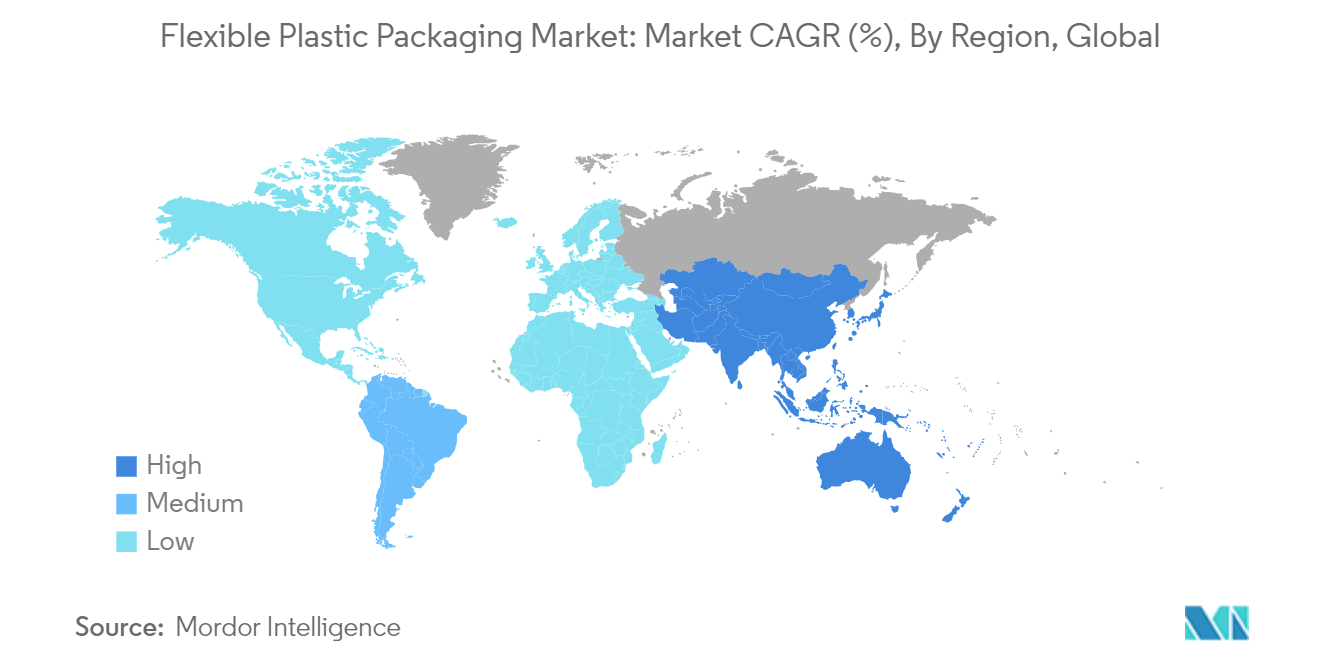Market Trends of Flexible Plastic Packaging Industry
BOPP Films are Gaining Traction due to the Demand for Versatile and Sustainable Packaging Solution
- Polypropylene film is a versatile packaging material that is becoming more popular in various industries. Its low density makes it cost-effective and a suitable replacement for polyethylene, polyvinyl chloride, polyester, and cellophane. It is used in packaging for stationery, cigarettes, and textiles. According to Plastic Europe, polypropylene comprised about 18.9% of total plastic production in 2022-2023.
- Biaxially oriented polypropylene (BOPP) film is stretched in two directions. This stretching makes the molecular chains align in two ways, giving BOPP its versatility. BOPP is a crucial polypropylene film type and a great alternative to waxed paper and aluminum foil. It has higher tensile strength and stiffness, better gas barrier properties, and lower haze than CPP.
- BOPP film is part of the polyolefin family, which can be laminated with polyethylene and is still recyclable. The push for sustainability has increased the use of BOPP film over other polymers. For example, in March 2024, Toppan Inc. and India's TOPPAN Speciality Films Private Limited (TSF) developed a BOPP-based GL-SP barrier film for sustainable packaging.
- BOPP films have excellent impact resistance, especially at low temperatures, and resist flex cracking. These properties make them popular in the food packaging industry, replacing cellophane in snack and tobacco packaging. BOPP films are ideal for food packaging because they protect the food's nutritional properties until consumption and offer good optical clarity, transparency, and gloss.
- Flexible plastic packaging often has lower specifications in the cosmetics and toiletries sector. BOPP films are used for overwraps for toilet tissue, wipes, sanitary products, perfume cartons, cosmetics, and men's toiletries. BOPP monolayers and laminates are standard for wrapping soap and toothbrushes. These films offer chemical resistance, a flat surface, and UV protection. They are also recyclable and do not emit toxic elements, which has increased their demand in recent years.

Flexible Plastic Packaging is Meeting Modern Consumer Needs and Enhancing the Product's Shelf Life
- Consumers are increasingly prioritizing products with extended shelf lives, driven by convenience and a desire to combat food waste. With its superior barrier properties, flexible plastic packaging shields items from moisture, oxygen, light, and other factors that compromise their quality and freshness. This primarily benefits perishable goods like food, beverages, pharmaceuticals, and personal care items.
- Modern lifestyle is marked by on-the-go consumption, smaller households, and a preference for convenience, which are well-suited for flexible plastic packaging. These solutions are not only lightweight and portable but also offer resealable options, catering to busy schedules. Single-serve and portion-controlled formats are gaining traction, meeting the demand for convenience and controlled portions.
- The surge in frozen food popularity reflects the shift in consumer habits towards quick and convenient meal choices, especially in developed nations. Flexible plastic packaging is pivotal in this narrative, offering easy-to-open formats that streamline meal preparation. Features like resealable closures and portion-sized packs further improve the convenience factor for consumers.
- The German food market, notably receptive to plant-based offerings, presents a lucrative avenue for exporters, particularly those from the United States. Flexible plastic packaging emerges as a standout choice for packaging and transporting these plant-based products, ensuring their quality remains intact through distribution and storage. The United States exporters can carve a competitive niche by capitalizing on the German market's appetite for extended shelf life and convenient packaging.
- The global shift toward plant-based diets reflects evolving consumer values, emphasizing health, environmental consciousness, and ethical considerations. Packaging innovations, such as resealable closures and portion-controlled packs, further elevate the appeal of flexible packaging solutions for these discerning consumers.


